- Details
- Hits: 11848
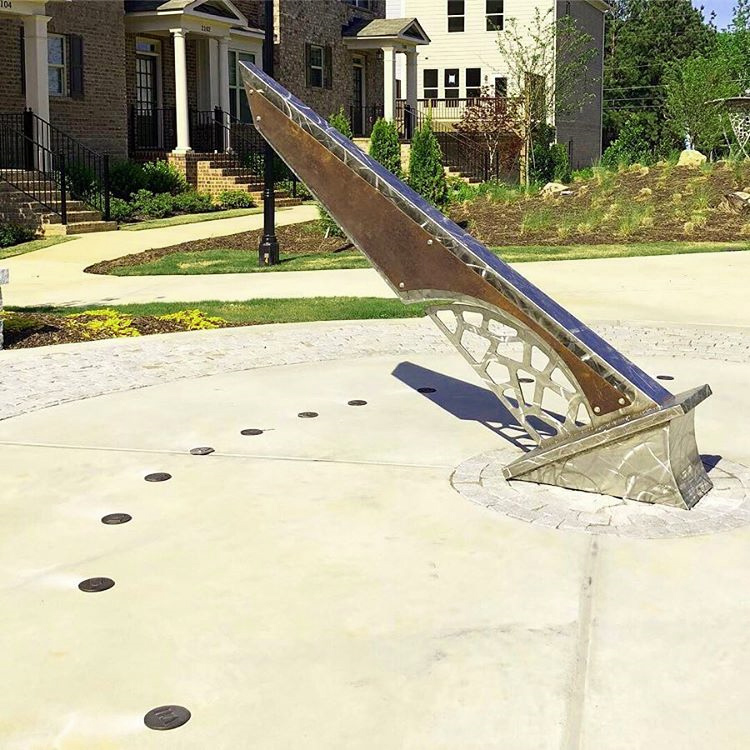 On May 3, 2019 new sundial graces the City of Kennesaw, Georgia just a short way from Atlanta. The Marietta Daily Journal reported the unveiling of the sundial, a large gateway sign, and a shade structure at the new townhouse site. Developers of Kennesaw Gateway Park, a new group of townhouses within walking distance of of town center, collaborated with Kennesaw State University (KSU) to design and fabricate a 9-foot tall horizontal sundial that has been placed in the circular plaza of the housing common area. Page Burch, a lecturer of KSU's Master Craftsman Program was the lead coordinator to design and fabricate the sundial gnomon. The stainless steel gnomon has a brass verneer and an unusual tilted based that nevertheless results in the the gnomon angle of 34 degrees exactly correct for the site latitude.
On May 3, 2019 new sundial graces the City of Kennesaw, Georgia just a short way from Atlanta. The Marietta Daily Journal reported the unveiling of the sundial, a large gateway sign, and a shade structure at the new townhouse site. Developers of Kennesaw Gateway Park, a new group of townhouses within walking distance of of town center, collaborated with Kennesaw State University (KSU) to design and fabricate a 9-foot tall horizontal sundial that has been placed in the circular plaza of the housing common area. Page Burch, a lecturer of KSU's Master Craftsman Program was the lead coordinator to design and fabricate the sundial gnomon. The stainless steel gnomon has a brass verneer and an unusual tilted based that nevertheless results in the the gnomon angle of 34 degrees exactly correct for the site latitude.
Credit is also given to the KSU College of Science and Mathematics for calculating the gnomon angles and hour lines for positioning the hour-mark disks. These disks are embedded in a circular arc in the concrete. The 6am-6pm disks line up behind the gnomon mount, but again are correct when the style edge is followed to th concrete floor, precisely intersecting the 6am-6pm line. No noon-mark separation was used to account for the approximate 6-inch width of the gnomon.
- Details
- Hits: 13112
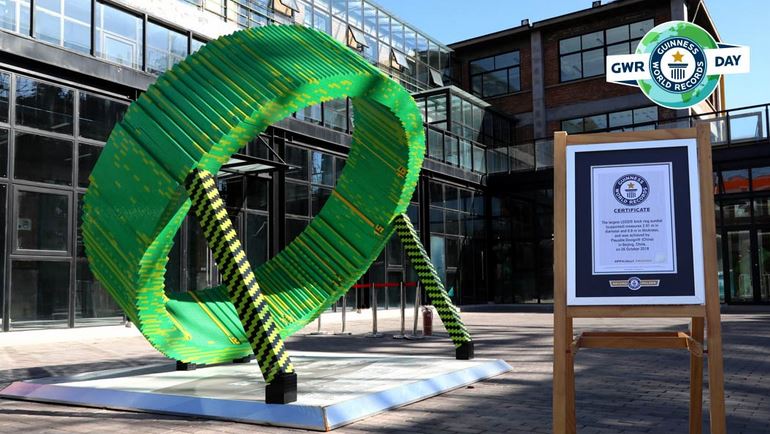 Back in March of 2012, NASS had an article about an inventive sundialist constructing a 62-LEGO block equatorial dial. That now seems like ancient history. In Beijing China, dialists have built a ring dial 9 1/2 feet in diameter consisting of more than 45,000 LEGO blocks, setting a new Guinness World Record.
Back in March of 2012, NASS had an article about an inventive sundialist constructing a 62-LEGO block equatorial dial. That now seems like ancient history. In Beijing China, dialists have built a ring dial 9 1/2 feet in diameter consisting of more than 45,000 LEGO blocks, setting a new Guinness World Record.
The dial was the idea of Mrs. Hou at Playable Design, a company that creates and develops eduational activities using LEGO construction blocks. Astronomical professionals and structural engineers were enlisted to guide this three month construction project. According to an article from the on-line Guiness World Records website, Mrs. Hou (founder of Playable Design), says the giant ring sundial "... is a teaching tool that allows children to learn sciences across disciplines including astronomy, mathematics, history and cosmology. Inspire children to think and ask questions, when they see the ring sundial, but we are all very excited to ber recognized by the Guinness World Records at the same time.... This is an important part of a public education project. For creators and educators like us, the process of learning never stops."
Watch the time-lapse video of the dial's construction:
<mp4>LEGO_sundial_construction_2018</mp4>
- Details
- Hits: 11901
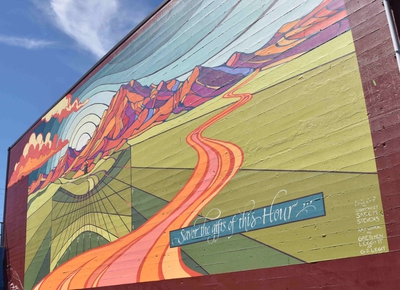 The Sundial Mural Project has been completed. Sasch Stephens of NW Sunworks spent years putting this project together and in association with Allied Arts sponsored an international competition that ultimately commissioned Gretchen Leggitt to paint a beautiful 30' x 60' wall mural incorporating the dial. The bright and engaging sundial mural is located on the south facing wall of 207 Unity Street in Bellingham, WA.
The Sundial Mural Project has been completed. Sasch Stephens of NW Sunworks spent years putting this project together and in association with Allied Arts sponsored an international competition that ultimately commissioned Gretchen Leggitt to paint a beautiful 30' x 60' wall mural incorporating the dial. The bright and engaging sundial mural is located on the south facing wall of 207 Unity Street in Bellingham, WA.
The dial and mural will be dedicated at noon Saturday, September 22, 2018 which coinsides with the date of the fall equinox. Called the "First Shadow Celebration" city council officials and noted sudialists will be present, as will Mataio Gills, co-owner of Ciao Thyme, the building that supports the mural and vertical dial. There will be music, entertainment, information about sundials, sundial kits, and a celebration of Solar Noon on the Equinox as seen on this major vertical sundial.
If you are in the Seattle-Bellingham-Vancouver area, head for the sundial dedication and First Shadow Celebration on the equinox, Saturday, Sept 22.
- Details
- Hits: 11941
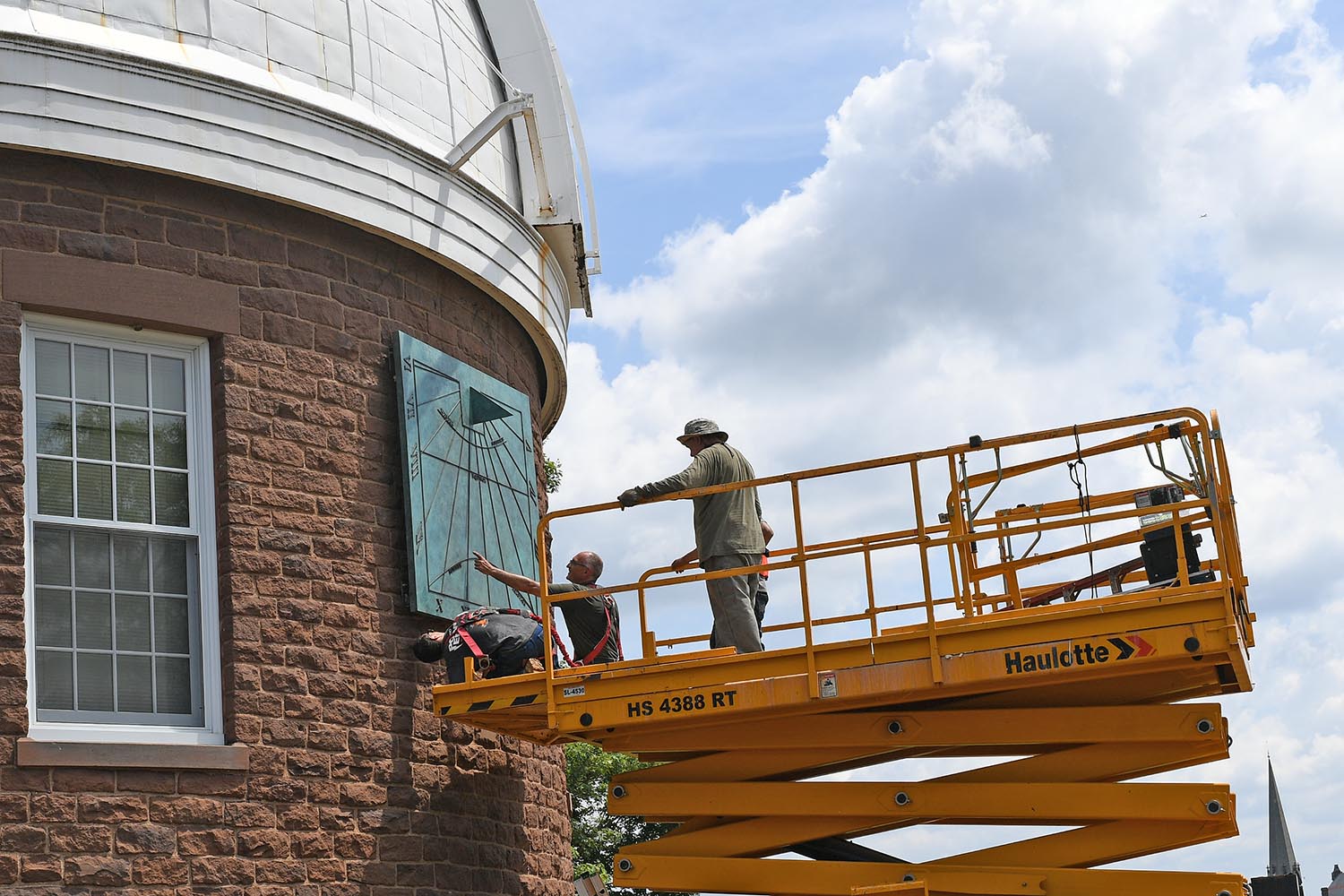 The Van Vleck Observatory has received a new sundial. In the Wesleyan news letter article by Olivia Drake who interviewed provost Joyce Jacobsen who said, "Campus doesn’t have enough outside art. A sundial is a perfect piece because it’s not only aesthetically pleasing but it’s functional too.” (https://newsletter.blogs.wesleyan.edu/2018/07/17/sundial-sculpture-installed-on-van-vleck-observatory/)
The Van Vleck Observatory has received a new sundial. In the Wesleyan news letter article by Olivia Drake who interviewed provost Joyce Jacobsen who said, "Campus doesn’t have enough outside art. A sundial is a perfect piece because it’s not only aesthetically pleasing but it’s functional too.” (https://newsletter.blogs.wesleyan.edu/2018/07/17/sundial-sculpture-installed-on-van-vleck-observatory/)
The 6 x 6 foot Muntz metal bronze sundial with stainless steel reinforcing weighing 650 pounds was carefully installed on the southern face of the 20-inch Clark Refractor dome on Foss Hill, Middletown, CT. The Alvan Clark telescope now open for public viewing was installed in July, 1922. In 1971 the Van Vleck observatory acquired the 24-inch Perkin reflector, housed in a separate dome near the west end of the old observatory building. (http://www.wesleyan.edu/astro/van-vleck/history.html)
The July 16th, almost exactly 96 years since the installation of the Clark telescope, the dome was graced by a sundial. Installation was supervised by the designer and creator, Robert Adzema (standing on the platform). He visited the campus multiple times with paper and wooden models seeking the right esthetic design. The final dial design is a true south declining sundial (notice the equinox line is parallel to the ground) but the hour lines are corrected for the longitude 72° 39.5585' W such that mean noon occurs 9m 22s after local mean noon. Hence a slight counter-clockwise twist to the hour lines (the 6am hour line is slightly below the horizontal). The shadow of the gnomon's tip traces the solstices and equinox. "I wanted the design to look timeless and in keeping with the classical nature of the building,” said Adzema. In Drake's article Adzema further commented on the patina of the bronze dial, saying, "I chose this green because it is the natural color bronze would oxidize over time. It is also a shade that looks great against the color of the observatory’s brownstone walls...The biggest difficulty was achieving the patina, which had to be applied by heating the surface of the dial and applying various chemicals and acids.”https://newsletter.blogs.wesleyan.edu/2018/07/17/sundial-sculpture-installed-on-van-vleck-observatory/
- Details
- Hits: 10013
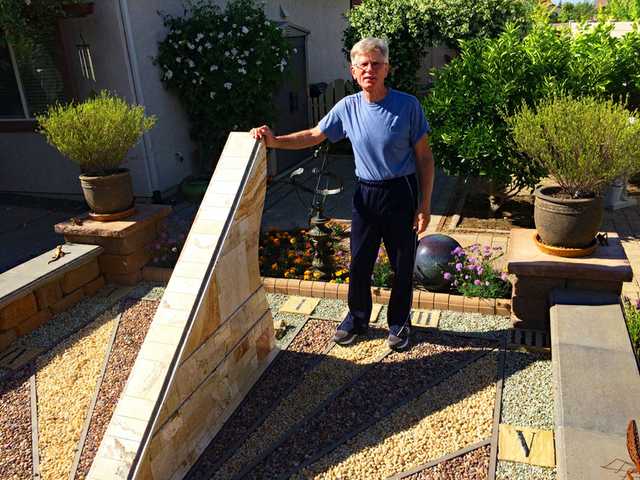 In a sunny corner of Ken & Molly Cooper's garden, located at their home in the Del Webb community of Manteca, CA, is an 8x12 foot horizontal sundial. The hours lines are delineated by alternating light tan and red stone pebbles. The hours themselves are squares of marble with Roman numerals from 6am to 6pm. The 4 foot gnomon is about six inches wide, made of a concrete core and flanked with marble. The hour lines are correctly laid out for a thick gnomon.
In a sunny corner of Ken & Molly Cooper's garden, located at their home in the Del Webb community of Manteca, CA, is an 8x12 foot horizontal sundial. The hours lines are delineated by alternating light tan and red stone pebbles. The hours themselves are squares of marble with Roman numerals from 6am to 6pm. The 4 foot gnomon is about six inches wide, made of a concrete core and flanked with marble. The hour lines are correctly laid out for a thick gnomon.
Surrounding the dial is a low brick wall decorated with lizards and butterflies. According to Rose Alban Risso, correspondent for the Manteca Bulletin, "The central focus [of the garden], a huge sundial that took him hundreds of hours to make, is the realization of a childhood dream and fascination with astronomy. The two concrete spheres here were hand painted by the retired PG&E employee. One is designated as the night sky and the other represents daytime. An armillary time piece occupies another corner of the sundial..."
- Details
- Hits: 9552
Normally when one mentions a human sundial, we think of an analemmatic dial carefully painted on the ground with a himan gnoman standing carefully on a date in the central walkway. But you can design a sundial that works for a day or two by just having a central platform, standing on it to become a gnomon, and letting your shadow fall on marked hours drawn on the ground below. But would you stand there all day? NASA presented their Astronomical Picture of the Day showing that "on July 19th, the Astronomy Group of students in the Progymnasium Rosenfeld created a human sundial, each participant patiently playing the role of a gnomon for 10 minutes. In this timelapse video of their temporal voyage of discovery, one image was taken every 20 seconds from 8 amuntil4 pm Central European Summer Time. Drawn on the ground are the dial hour marks calculated to show the local time for that specific date. Behind, the tower clock offers a time check... The group plans a repetition of this performance next winter to compare the length of the day and the altitude of the sun."
Video by permission of Astronomie-AG, Progymnasium Rosenfeld, Till Credner, AlltheSky.com
- Details
- Hits: 12219
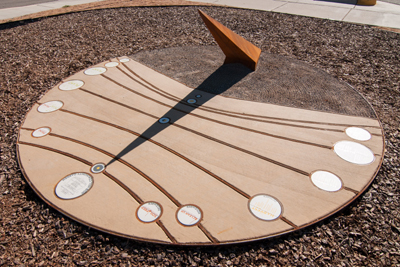 Sad note: A recent check of Google shows that the dial was removed in early 2016 and the lot that supported garden education is now a housing complex.
Sad note: A recent check of Google shows that the dial was removed in early 2016 and the lot that supported garden education is now a housing complex.
In a small park at the intersection of Morningside Dr SE and Silver Ave SE in Alburquerque, NM. is a unique horizontal sundial designed for the Nob Hill Main Street program, where the 10-foot diameter sundial anchors the southeast corner of the Nob Hill Community Garden. Created several years ago by Mike Heighway and Mira Rose, Mike explains, "The purpose of the Nob Hill Sundial is to act as an interactive gardener’s guide. It works on an annual cycle by casting a shadow from a large center piece (the gnomon) onto a concrete plate with embedded steel [diurnal] bands and porcelain tiles that describe that month’s gardening activities."
The sundial acts as an educational tool for gardeners to show what to plant throughout the year, and when to harvest. Instructions are on porcelain tiles. There are a total of 17 tiles — one tile for each month of the year, one winter solstice tile, one summer solstice tile, one tile for both equinoxes, a centering tile (the tile which dictates the very center of the design), and a "hero" tile in the shape of a historic U.S. highway sign with information about contributors to the project. Most prominent is the acknowledgement of the Garden Design by Robert Strell and Grant Funding from the New Mexico Centennial Foundation.
Read more at http://www.mikeheighway.com/projects/nhsd.html
- Details
- Hits: 10061
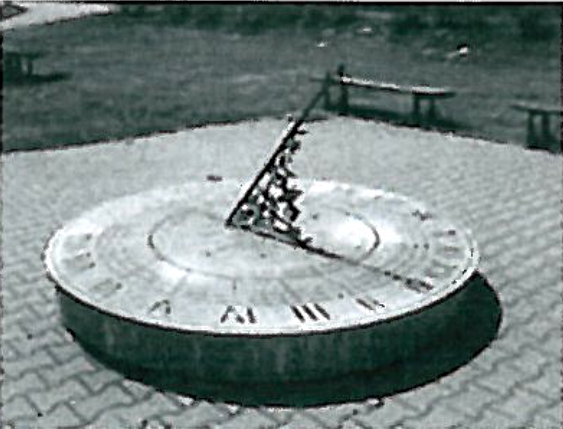
Photo: PL 664 Sundial at School in Janowice Janowice Rybnickie just south of Rybnik
|
The sundials working group of the Czech Astronomical Society in Hradec Králové organized a short study tour to Poland in June 2016 with a special emphasis on seeing sundials. This report is provided by Hohumil Landsman:
"The first stop was the Muzeum im. Przypkowskich, the world famous museum that began as the clock collection of the Przypkowski family. It is situated in the town square of Jędrzejów. As well as various fixed and portable sundials, the museum showed devices for the construction of sundials and several old books on astronomy and gnomonics."
"From there we visited the Planetarium and Observatory of Youth in Niepołomice. Among other things, there were commentaries available for blind visitors for whom the spoken word is a principal source of information. Another interesting stop was the Silesian Planetarium and Astronomical Observatory of Nicolaus Copernicus in Chorzów. In the courtyard of the planetarium there is a large sundial showing local solar time, and in the basement we found a seismological station containing two early 20th-century seismographs as well as their more modern equivalents. A meteorological station forms part of the same complex of buildings. As an additional diversion, we also visited the salt mines in Wieliczka."
- Details
- Hits: 13400
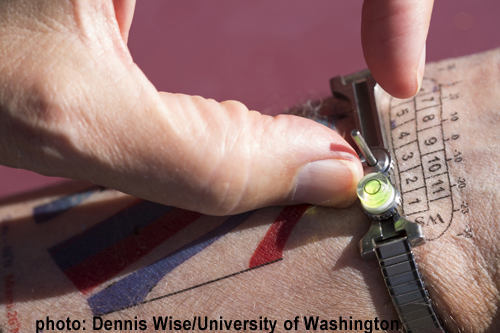 Woodruff (Woody) T. Sullivan III hosted two NASS conferences, one in 1998 and a second in 2011, each time showing many new Seattle sundials...most of which he had a helping designer's hand. Woody made T-shirts proclaiming "Seattle - sundial capital of North America". Now in the on-line University of Washington Today for December 1, 2016, Peter Kelley profiled Professor Emeritus Sullivan, noting the many worlds of interest by the UW astronomer and astrobiologist...including his passion for sundials. In Kelley's interview Woody expounded "My sundial interest began very specifically in 1991. I got interested because three years before we moved in to the new Physics-Astronomy building in 1994, the architects asked , what do you want? I'm thinking of my interest in history of science and art and design, so I casualy said, 'A sundial would be nice'. Since then, it's hard to believe - like getting married - that there's a phase in my life before that."
Woodruff (Woody) T. Sullivan III hosted two NASS conferences, one in 1998 and a second in 2011, each time showing many new Seattle sundials...most of which he had a helping designer's hand. Woody made T-shirts proclaiming "Seattle - sundial capital of North America". Now in the on-line University of Washington Today for December 1, 2016, Peter Kelley profiled Professor Emeritus Sullivan, noting the many worlds of interest by the UW astronomer and astrobiologist...including his passion for sundials. In Kelley's interview Woody expounded "My sundial interest began very specifically in 1991. I got interested because three years before we moved in to the new Physics-Astronomy building in 1994, the architects asked , what do you want? I'm thinking of my interest in history of science and art and design, so I casualy said, 'A sundial would be nice'. Since then, it's hard to believe - like getting married - that there's a phase in my life before that."
That UW sundial was a large vertical decliner, entered in the NASS Sundial Registry as Dial #117. But now a new precision sundial...using an arm tattoo. Woody explained, "This started with a paleontologist graduate student in the astrobiology program. She likes sundials and we got talking and over the last couple of years we designed [a tattoo sundial]. The idea was for her to have it, but she how has her degree and has since left town. Meanwhile I said to myself, dammit - that would be pretty neat. In April I gave a talk to the British Sundial Society about the technical details and showed the decal I'd made for my inner forearm. I'm going to write it up for their publication. The world's first working sundial tattoo!"
Read more at:: http://www.washington.edu/news/2016/12/01/the-many-worlds-of-uw-astronomer-and-astrobiologist-woody-sullivan/
